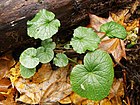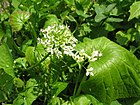Note: This is a project under development. The articles on this wiki are just being initiated and broadly incomplete. You can Help creating new pages.
Difference between revisions of "Eutrema japonicum - Wasabi"
m (Prabhakar moved page Wasabi to Wasabi (Eutrema japonicum)) |
|||
| (30 intermediate revisions by 2 users not shown) | |||
| Line 1: | Line 1: | ||
[[File:Wasabia japonica 4.JPG|thumb|right|''Wasabi'']] | [[File:Wasabia japonica 4.JPG|thumb|right|''Wasabi'']] | ||
| + | '''Wasabi''' is a plant of the Brassicaceae family, Which includes cabbages, horseradish, and mustard. The plant grows naturally along stream beds in mountain river valleys in Japan. | ||
| + | ==Uses== | ||
| + | {{Uses|Heart problems}}, {{Uses|Cancer}}, {{Uses|Osteoporosis}}, {{Uses|Sinuses}}, {{Uses|Arthritis}}, {{Uses|Respiratory problems}}, {{Uses|Sore throats}}. | ||
| − | + | ==Parts Used== | |
| + | {{Parts Used|Stem}}, {{Parts Used|Roots}}. | ||
| − | == | + | ==Chemical Composition== |
| + | MITC, methylthioheptyl isothiocyanate, methylthiooctyl, isothiocyanate<ref name="chemical composition"/> | ||
| − | + | ==Common names== | |
| − | + | {{Common names|kn=|ml=|sa=|ta=|te=|hi=|en=Agrimony}} | |
| − | |||
| − | |||
| − | == | + | ==Properties== |
| + | Reference: Dravya - Substance, Rasa - Taste, Guna - Qualities, Veerya - Potency, Vipaka - Post-digesion effect, Karma - Pharmacological activity, Prabhava - Therepeutics. | ||
| + | ===Dravya=== | ||
| − | * ''' | + | ===Rasa=== |
| + | |||
| + | ===Guna=== | ||
| + | |||
| + | ===Veerya=== | ||
| + | |||
| + | ===Vipaka=== | ||
| + | |||
| + | ===Karma=== | ||
| + | |||
| + | ===Prabhava=== | ||
| + | |||
| + | ==Habit== | ||
| + | {{Habit|Herb}} | ||
| + | |||
| + | ==Identification== | ||
| + | ===Leaf=== | ||
| + | {{Leaf|Simple||The leaves are divided into 3-6 toothed leaflets, with smaller leaflets in between}} | ||
| + | |||
| + | ===Flower=== | ||
| + | {{Flower|Unisexual|2-4cm long|Yellow|5-20|Flowers Season is June - August}} | ||
| + | |||
| + | ===Fruit=== | ||
| + | {{Fruit|||Clearly grooved lengthwise, Lowest hooked hairs aligned towards crown|With hooked hairs|}} | ||
| + | |||
| + | ===Other features=== | ||
| + | |||
| + | ==List of Ayurvedic medicine in which the herb is used== | ||
| + | * [[Vishatinduka Taila]] as ''root juice extract'' | ||
| + | |||
| + | ==Where to get the saplings== | ||
| + | ==Mode of Propagation== | ||
| + | {{Propagation|Seeds}}, {{Propagation|Cuttings}}. | ||
| + | |||
| + | ==How to plant/cultivate== | ||
| + | Prefers a position in wet soil or shallow water<ref name="How to plant/cultivate"/> | ||
| + | |||
| + | ==Commonly seen growing in areas== | ||
| + | {{Commonly seen|Humid area}}, {{Commonly seen|Temperate area}}. | ||
| + | |||
| + | ==Photo Gallery== | ||
| + | <gallery class="left" caption="" widths="140px" heights="140px"> | ||
| + | |||
| + | |||
| + | Daio wasabi farm11s1800.jpg|Stems | ||
| − | |||
| − | + | Folia wasabiae.jpg|Leaf | |
| − | + | ||
| − | <ref name=" | + | |
| − | + | Wasabi 071103.jpg|Leaves | |
| + | |||
| + | |||
| + | Wasabi bud.jpg|Flower | ||
| + | File:Wasabia japonica 3.JPG|Flowers | ||
| + | File:Wasabia japonica 1.JPG|Capsules | ||
| + | |||
| + | </gallery> | ||
| + | |||
| + | ==References== | ||
| + | |||
| + | <references> | ||
| + | <ref name="chemical composition">[https://en.wikipedia.org/wiki/Wasabi Chemistry]</ref> | ||
| + | |||
| − | |||
| − | + | <ref name="How to plant/cultivate">[https://www.herbwisdom.com/herb-wasabi.html Cultivation details]</ref> | |
| + | </references> | ||
| + | ==External Links== | ||
| + | * [http://ayushology.com/health-benefits-of-herbs/health-benefits-of-wasabi/ Health Benefits of Wasabi] | ||
| + | * [https://ayurvedamedicare.com/herbs/wasabi/ Wasabi on ayurveida medicare] | ||
| + | * [https://wasabi.org/articles/medical-uses-of-wasabia-japonica/ Medical Uses of Wasabia japonica] | ||
| + | * [https://india.curejoy.com/content/health-benefits-of-wasabi/ Wasabi: The Health Benefits] | ||
[[Category:Herbs]] | [[Category:Herbs]] | ||
| + | [[Category:Ayurvedic herbs that don't have seed photos]] | ||
| + | [[Category:Brassicaceae]] | ||
Latest revision as of 11:53, 6 May 2020
Wasabi is a plant of the Brassicaceae family, Which includes cabbages, horseradish, and mustard. The plant grows naturally along stream beds in mountain river valleys in Japan.
Contents
- 1 Uses
- 2 Parts Used
- 3 Chemical Composition
- 4 Common names
- 5 Properties
- 6 Habit
- 7 Identification
- 8 List of Ayurvedic medicine in which the herb is used
- 9 Where to get the saplings
- 10 Mode of Propagation
- 11 How to plant/cultivate
- 12 Commonly seen growing in areas
- 13 Photo Gallery
- 14 References
- 15 External Links
Uses
Heart problems, Cancer, Osteoporosis, Sinuses, Arthritis, Respiratory problems, Sore throats.
Parts Used
Chemical Composition
MITC, methylthioheptyl isothiocyanate, methylthiooctyl, isothiocyanate[1]
Common names
| Language | Common name |
|---|---|
| Kannada | |
| Hindi | |
| Malayalam | |
| Tamil | |
| Telugu | |
| Marathi | NA |
| Gujarathi | NA |
| Punjabi | NA |
| Kashmiri | NA |
| Sanskrit | |
| English | Agrimony |
Properties
Reference: Dravya - Substance, Rasa - Taste, Guna - Qualities, Veerya - Potency, Vipaka - Post-digesion effect, Karma - Pharmacological activity, Prabhava - Therepeutics.
Dravya
Rasa
Guna
Veerya
Vipaka
Karma
Prabhava
Habit
Identification
Leaf
| Kind | Shape | Feature |
|---|---|---|
| Simple | The leaves are divided into 3-6 toothed leaflets, with smaller leaflets in between |
Flower
| Type | Size | Color and composition | Stamen | More information |
|---|---|---|---|---|
| Unisexual | 2-4cm long | Yellow | 5-20 | Flowers Season is June - August |
Fruit
| Type | Size | Mass | Appearance | Seeds | More information |
|---|---|---|---|---|---|
| Clearly grooved lengthwise, Lowest hooked hairs aligned towards crown | With hooked hairs | {{{6}}} |
Other features
List of Ayurvedic medicine in which the herb is used
- Vishatinduka Taila as root juice extract
Where to get the saplings
Mode of Propagation
How to plant/cultivate
Prefers a position in wet soil or shallow water[2]
Commonly seen growing in areas
Photo Gallery
References
External Links
Categories:
- Ayurvedic Herbs known to be helpful to treat Heart problems
- Ayurvedic Herbs known to be helpful to treat Cancer
- Ayurvedic Herbs known to be helpful to treat Osteoporosis
- Ayurvedic Herbs known to be helpful to treat Sinuses
- Ayurvedic Herbs known to be helpful to treat Arthritis
- Ayurvedic Herbs known to be helpful to treat Respiratory problems
- Ayurvedic Herbs known to be helpful to treat Sore throats
- Herbs with Stem used in medicine
- Herbs with Roots used in medicine
- Herbs with common name in English
- Habit - Herb
- Index of Plants which can be propagated by Seeds
- Index of Plants which can be propagated by Cuttings
- Herbs that are commonly seen in the region of Humid area
- Herbs that are commonly seen in the region of Temperate area
- Herbs
- Ayurvedic herbs that don't have seed photos
- Brassicaceae






